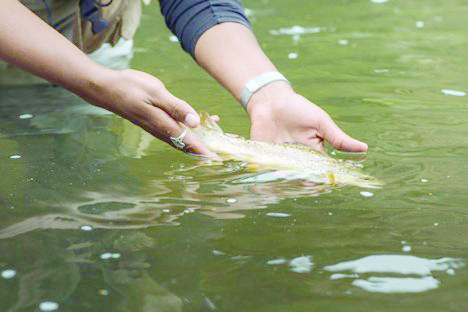SOUTH FORK – This past weekend I packed my 3 weight Sage fly rod and headed out to fish some of the area streams around South Fork. My first destination was the headwaters of Beaver Creek high above the reservoir. I decided to “wet wade” and not don my waders. The water was cool but not as cold as I had expected. In a two hour timeframe I was able to catch and release over a dozen brook trout and one native cutthroat. An early afternoon thunderstorm cut my outing short.
The following morning I headed out to the South Fork of the Rio Grande to try my luck. Again, I was wet wading and the water temperature was noticeably much warmer, bathwater temperature, and the flow was very minimal. There were noticeable algae blooms throughout the river that kept hanging on to my nymph patterns. After over two hours without a single strike, and not seeing any signs of fish feeding, although there was a small caddis hatch going off, I called it quits. The one deep pool that I found, which was only thigh deep, did hold a few trout but they would not take any pattern that I presented.
What was the difference between the two days of fishing? I surmised that it had to be the water temperature.
Trout are cold-water fish and the general rule for ethical fly fishermen is that when the water temperature reaches 70 degrees you stop fishing. Most likely the fish have already stopped feeding due to being stressed by the higher water temperatures.
Research varies but in general The temperature that a Brook Trout begins to stress is 65 degrees Fahrenheit with prolonged exposure to 70 degrees possibly being lethal. When the water temperature is above 60 degrees cutthroat trout will begin to become stressed and feed less. Rainbow and Brown trout can handle higher water temperatures with 68 degrees bring on stress and temperatures above 75 for prolonged periods possibly resulting in death.
July 21 the Del Norte river gauge for the Rio Grande reported the water temperature was 16.2 C° (61.1 F°). The highest recent temperature occurred July 19 when the temperature reached 17 C° (62.6 F°). The river flow July 21 was only 330 cubic feet per second (CFS) which is approximately 1,000 CFS below the 121 year average for that date. At the Lobatos river gauge in Conejos County, the Rio Grande’s flow was only 40.7 CFS with the 120 year average being 390 CFS and the water temperature was 21.6 C° (70.8 F°).
According to Colorado Parks and Wildlife (CPW) heat, extreme drought, and low water levels are contributing to elevated water temperatures in much of Colorado, depleting oxygen levels and leaving trout vulnerable. Trout function best in 50-60 degree waters. When temperatures exceed 70 degrees, they often stop feeding and become more susceptible to disease. Warm temperature and low water levels can also lead to algae blooms in rivers and reservoirs which cause oxygen levels to drop when algae die and decompose.
“CPW recommends anglers hit the water early in the morning to avoid the higher water temperatures commonly seen in the afternoon and evening,” said Matt Nicholl, CPW’s Aquatic Section Manager.
“Anglers are also encouraged to seek out high-elevation trout lakes and streams, where water temperatures are more suitable and fishing doesn’t potentially add additional stress.”
Other CPW suggestions include using heavier tippet and line to quickly reel in and release the fish and using barbless hooks to reduce the time required to unhook the fish. When fish are hooked, their metabolic rate and oxygen consumption soar, greatly increasing their risk of disease and death, especially if water conditions are marginal.
CPW reminds anglers to always wet your hands before handling fish, and to keep the fish submerged while unhooking and releasing it. Avoid taking the fish out of the water even for a quick photo in these conditions.
“Anglers should monitor water temperatures and end their trout fishing adventures when water temperatures start to approach 70 degrees,” he said. “If trout have difficulty recovering after being caught and are acting lethargic, it’s a good decision to call it quits for the day.”
Credit: Source link






























